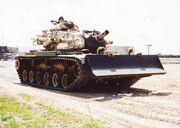
Military armored car (MMV)
Historically, armored vehicles were designed to protect soldiers and other personnel from light arms fire. It was wildly effective. A technological war ensued that forced each side of the fence to develop greater machines in an attempt to one up the other. In the end, armored vehicles became an important part of any battlefield engagement.
The role of armored vehicles has since diminished in the modern world of orbital bombardment and starfighters, but the same old adage of war remains: You cannot hold land without armor.
Hovering technology is not prevalent with armored war machines because of the intense amount of energy needed to support the weight associated with armor. The weight-to-lift ratio of the modern hoverengine is either insufficient or inpractical for military purposes.
Types of vehicles[]

Armored personnel carrier (APC)
A civilian armored car resembles an ordinary truck. It has bulletproof glass and a ventilating system to foil tear gas attacks. These vehicles are used to pick up and deliver money for mints, banks, and businesses that handle large amounts of cash.
Military armored cars are used for scouting and patrolling of hostile cities. They are also used by police forces for riot control. These vehicles are wheeled and thus are faster and more maneuverable than tanks, which run on treads. They are, however, not as heavily armored.

Armored fighting vehicle (AFC)
Multipurpose military vehicles (MMV) resemble a normal passenger car. It is very lightly armored and is capable of resisting pistol and low-velocity rifle fire. MMVs are used for fast transportation to and from front lines. It may mount any variety of weapon, including machine gun, missile launcher, or grenade launcher.
Armored personnel carriers (APC) transport infantrymen to the front lines where they dismount and fight. The APC is also used as a command post or first-aid station. It is lightly armored and is equipped with a machine gun. An APC that can propel itself through shallow water is sometimes called an assault amphibian vehicle.

Combat engineer vehicle (CEV)
Armored fighting vehicles (AFV), also called infantry fighting vehicles (IFV), are moving battle stations. Infantrymen fire their weapons through small openings in the hull. The AFV is more heavily armored than the APC and is equipped with a cannon, machine gun, and sometimes missiles.
Armored command and reconnaissance vehicles may mount several machine guns. Modern reconnaissance vehicles are fully tracked, like tanks. They serve as command stations or front line observers.
Self-propelled artillery includes armored vehicles mounting howitzers, long-range guns, antiaircraft guns, mortars, and battlefield missiles. They are normally fired while the vehicle is stationary and far from the fighting front.
Combat engineer vehicles (CEV) are designed to remove obstacles blocking tanks or infantry. Such a vehicle is equipped with a winch, booms, and bulldozer blades. It carries a heavy gun that is used mainly for demolition. Certain CEVs can clear and detect mines or other buried threats.
Tanks[]
The tank is an armored motor vehicle designed to fight while it is moving. It differs from other armored vehicles in that its primary mission is to attack, rather than defend, transport, or scout. The tank is the principal weapon of all ground advances and an important supporting weapon of infantry divisions. Tanks move on crawler, or Caterpillar-type, tracks, permitting them to travel cross country. Most present-day tanks have maximum speeds of 48 to 72 km/h and can travel about 210 to about 480 km without refueling.
The main gun of a modern tank ranges in size (bore diameter) from 75 to 125 mm and is usually mounted on a turret that can be turned in a full circle. The effective range of the gun varies with the type of ammunition and the target. A high velocity 105-mm gun can be effective against a tank up to 3200 m away and against troops at a distance of about 7300 m. A gyroscopic stabilizing device, much like those found on personal combat armor, steadies the gun to keep it on target when the tank is moving over rough ground. Tanks also carry machine guns.

Tank in action
The typical tank has a crew of four--a commander, a driver, a gunner, and a loader. Newer versions replace the loader with a penumatic system that is controlled by the commander.
There are two basic kinds of tanks, the main battle tank (MBT) and the light tank. The MBT is heavily armored and weighs from 28 to 40 metric tons. The caliber of its main gun ranges from 105 to 125 mm. The MBT is primarily an offensive weapon, designed to break through enemy defenses to accomplish any of several missions--open the way for infantry, cut the enemy's supply lines, or dash ahead and capture strategic points. Even in a defensive situation, the MBT, where possible, is employed offensively, meeting enemy tanks with attacks of its own.
The light tank is less heavily armored and usually less well-armed, carrying a 75-mm or 90-mm gun. It is designed for reconnaisance, but sometimes is outfitted with a 105-mm gun to perform as a low-cost substitute for the MBT. Because of its relatively light weight, about 13 metric tons, the light tank can be easily transported in airplanes and spacecraft for use by airborne assault forces. Light tanks are also used in counterinsurgency warfare and in quelling civil disturbances.
All tanks have certain limitations. They are handicapped in mountainous or swampy regions. Increases in armor protection and in weight of armament cut down speed and cruising range. Maintenance of the complicated machinery is a constant problem, as is supply, especially of fuel and ammunition.